And the answer is…Catmongoose
No one hazarded a guess on the puzzle posted last week. It’s an interesting animal I found most curious. Here is the puzzle again.
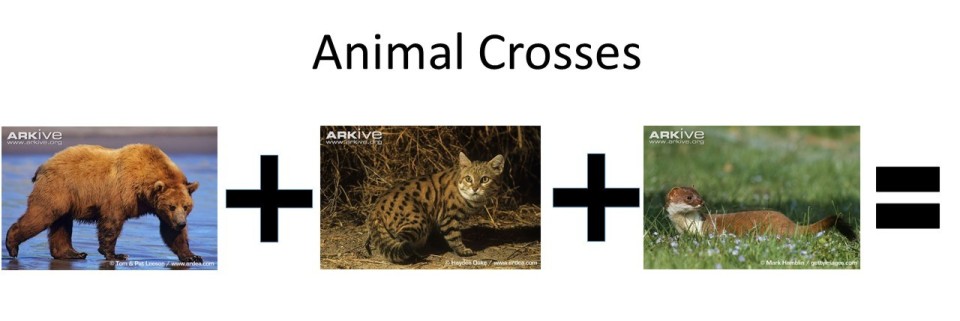
The animal this refers to is often referred to as a bearcat or occasionally bearweasel, although it is neither a bear, nor a cat, nor a weasel. Of the three, it is most closely related to the cats. What I am talking about is the binturong, aka Arctictis binturong.
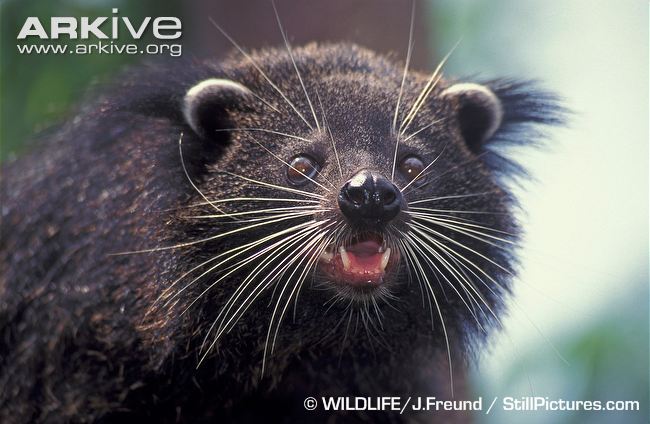
Binturongs live in the tropical rain forests of southeast Asia and are viverids, along with civets, linsangs, and genets. If you’re like most people, you may have a vague recollection of what a civet might be and no idea at all what linsangs and genets are. Fortunately, Toni Llobet has very helpfully illustrated them for the Handbook of the Mammals of the World, Vo1. 1: Carnivora, in 2009. He’s done a huge number of excellent illustrations for that text. If you are at all interested in mammal diversity, it is worth checking out.
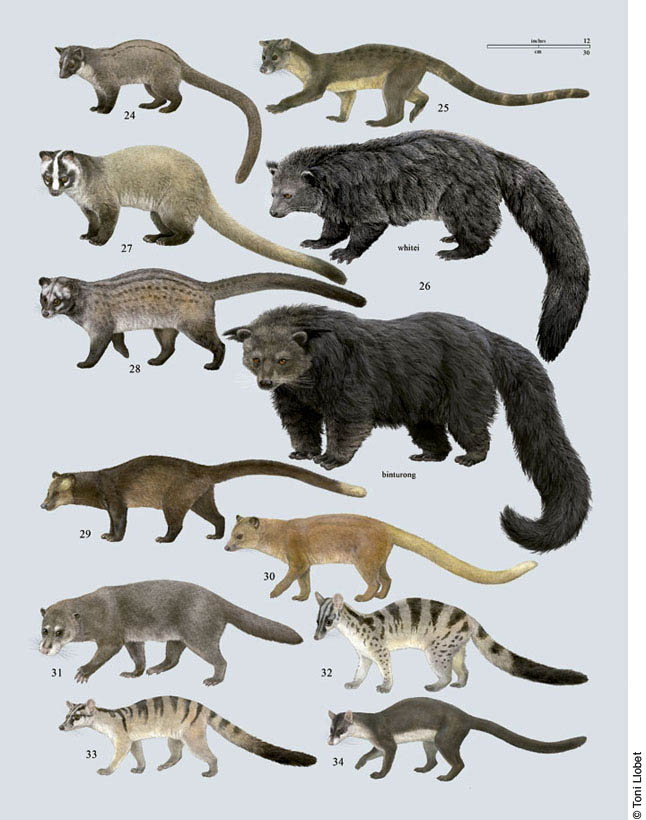
Binturongs look tough and surly, with bushy black or brown fur with whitish or rust-colored highlights giving them a grumpy old man kind of look. They are in the Order Carnivora, so that would seem to fit, but in reality they tend to spend their days sleeping and their nights ambling around the trees looking for fruit. While fruit is their favorite, they aren’t too picky, and will pretty much anything they come across that doesn’t run away fast enough, which doesn’t have to be that fast because the binturong isn’t going to bother chasing down a meal when pretty much everything qualifies as a potential meal.
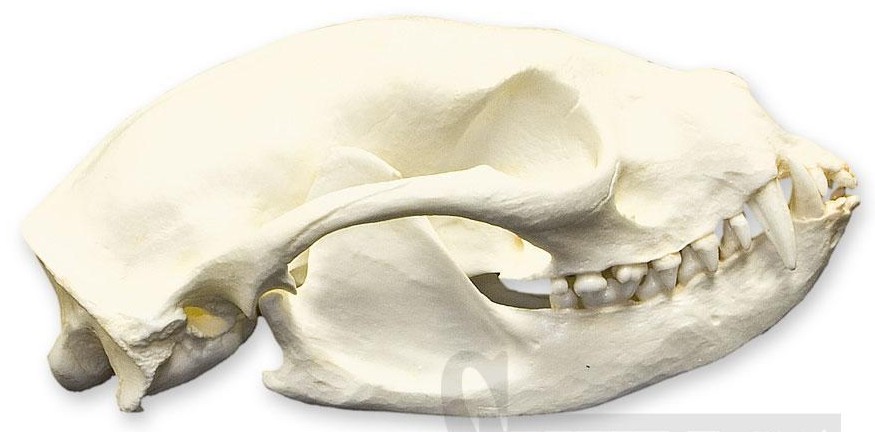
Binturong skull. Look at those teeth! Picture from Skulls Unlimited.
Many mammals use scent to mark their territory and to advertise and often have particular glands to make oils that carry the scent. Binturongs have an unusually distinctive smell. It is said they smell like buttered popcorn. The San Diego Zoo has a nice web page about them (which served as the main reference for the last two paragraphs) if you want to read more about them.
I said earlier that Binturongs are often referred to as bearcats, and occasionally as bear weasels. This is one of the things I find interesting about them because, other than all of them being in the Order Carnivora, none of those four are related. There is some debate as to the precise relationships within the carnivorans, but all the hypotheses put these animals in separate clades, or groups.
Before I get into this, there are a couple of things I want to clarify for the non-phylogenetically trained readers. A species can also be called by a more general term called a taxon. A taxon (plural taxa) is simply a species or group of related species. Mammalia is a taxon that contains all the mammalian taxa. If a researcher uses a method called cladistics, which almost everyone these days does, every taxon above species can also be called a clade. This was done to get rid of trying to come up with names for all the different ranks. When you got really detailed, it got kind of ridiculous having Sub-infra-super-supra-mega-gigantor-gonzo-teenytiny…attached onto everything. The number of prefixes could get absurd. It also gave people the false sense that things like Families or Orders actually meant comparable things when in reality they meant nothing at all, yet people still insisted on comparing them as if they meant the same things. A family of insects has little evolutionary similarity with a family within mammals and should not be compared. Taking away ridiculous names lessened (but sadly did not stop) the proclivities of people to do silly things like that. All these relationships can be mapped onto what is called cladograms or phylogenetic “trees”.
Now that everyone understands all that, it is important to understand that when scientists talk about carnivores and carnivorans, they are talking about two entirely different things, which, I know, is stupidly confusing and the scientists who are responsible for this should be slapped soundly and I humbly apologize. Carnivores refers to animals that eat meat as their primary diet. It has nothing to do with their relationships to one another and this is the way most people think about the term carnivores. Wolves are carnivores, just as are sharks, even though one would have to go very, very, very far back to find a common ancestor. Carnivorans, on the other hand, are those animals within the the Clade Carnivora. These animals include all animals more closely related to cats and dogs than anything else, including hyaenas, bears, seals, pandas, weasels, raccoons, skunks, and many other animals, including viverids. Carnivora is based on relationships, not diet. Thus, not all carnivorans are carnivores.
Now that I have gone through all that, binturongs are omnivorous, not carnivorous, carnivorans. As I stated earlier, they belong to the clade Viverridae. How do they relate to bears (Ursidae), cats (Felidae), or weasels (Mustelidae)? It is a bit of a debate, but they are closer to cats than the others. The first thing to know is that clade Carnivora is generally split into two major groups: Feliformia, the cat-like animals, and Caniformia, the dog-like animals. Here is a supertree published in 2012. A supertree is basically a compilation showing the consensus of a whole bunch of published trees of different parts. Each species that is added to the list increases the number of possible relationships exponentially, so trying to make a tree that shows all the species of carnivorans gets mathematically hideously complex. So people study their favorite group within Carnivora and then a supertree is put together with all of them together.

Nyatura and Bininda-Emonds chose to make their tree in a circular format, which is popular for including a large number of species, but is unfortunately the most difficult format for people to understand. It works just the same as all the other trees, it is just bent around and following the lines connecting the groups may be difficult for some.
At any rate, all the clades making up Caniformia are above the dotted line, which I added to hopefully make this easier to read, and all the clades in Feliformia are below the line. Viverrids, including our friend the biturong, is in purple at the bottom, most closely associated with groups like the Hyaenidae (hyaenas), Herpestids and Eupleridae (mongoose, fossa, and meerkats), and then of course, less closely, the felids. The bears and weasels are both in Caniformia and quite far removed from the biturong.
Here is another view of the data in a much simpler format to understand, published by Blaire Van Valkenburgh et al. in 2014.
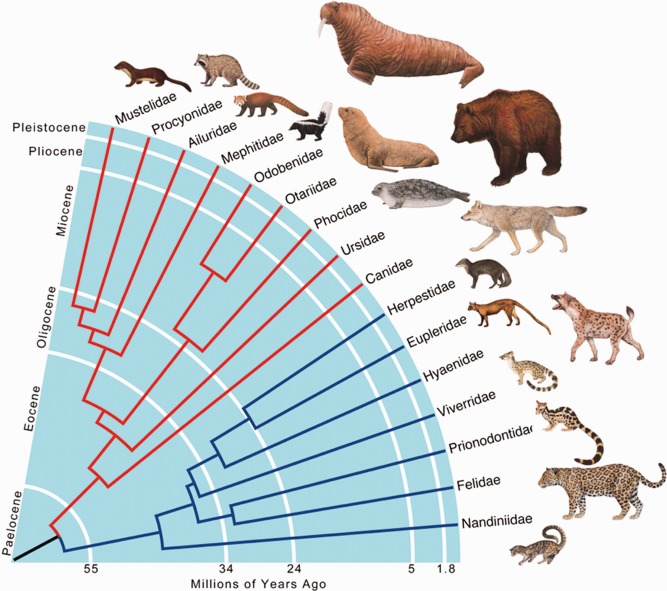
Other phylogenies may differ slightly by placing the viverrids a bit closer to the prionodontids and felids than hyaenids, but most everyone agrees that is the general area they belong. From this it is quite clear that viverrids are their own thing and only superficially resemble any of the animals they are often referred to as, but evolutionarily, they share a much closer common ancestor with cats than they do with either bears of weasels. So they aren’t bear-like cats, or cat-like bears, or weasel-like, bear-like cats. We humans just like to say it’s like this crossed with that to fit it into our neat categories of memory. If we really wanted to be accurate, we would call them mongoosecats or hyaenacats, or maybe even more accurately cat-like mongoose.
What could it be?
I haven’t done an animal cross game in a while, so when I ran across this animal, I thought it time to do another one. I was not familiar with this whiskery creature, but found it fascinating as soon as I saw it. I’m sure you will too, if you can figure out what it is. The animal is a living animal and as you can probably expect, a mammal. It is also on the endangered species list as a vulnerable species.

Put your guesses in the comments or join the conversation on Facebook and we’ll see if anyone can figure it out before I reveal the answer.
A Trio of Terror
Today I am going to do something a bit different. The books I usually talk about here are ones that I am recommending to people to check out. Today I am going to talk about a few that I do not recommend and why they don’t pass muster. As a result, I am not going to be putting quite as much information about the books because they aren’t ones I really want people to seek out and buy. I want you to avoid them when you see them and books like them. I have mentioned them very briefly on the Facebook page, but I wanted to talk about them a little more here for a less ephemeral record.
 The first book on the list is A Weekend with Dinosaurs. This book is put out by Raintree, an imprint of Capstone Global Library. This book came out in 2014 as part of their “Fantasy Science Field Trips” Read Me! series for elementary schools. They list it as reading level grades 1-3, but interest level grades 3-5, which I think kind of whacked, but that is just my personal opinion because dinosaurs are of interest to all ages in my (entirely biased, of course) opinion.
The first book on the list is A Weekend with Dinosaurs. This book is put out by Raintree, an imprint of Capstone Global Library. This book came out in 2014 as part of their “Fantasy Science Field Trips” Read Me! series for elementary schools. They list it as reading level grades 1-3, but interest level grades 3-5, which I think kind of whacked, but that is just my personal opinion because dinosaurs are of interest to all ages in my (entirely biased, of course) opinion.
The book is written by Claire Throp and I must say up front that the atrociousness of this book is not entirely her fault. The words in the book are not terrible as far as they go. So let’s take a look at that first.It begins with going back in time 230 million years to begin the field trip at the beginning of the dinosaurs. It’s written in a fun and interesting way which is, I think, just right for the desired tone and age range of the audience. She sets it up well, even mentioning that different dinosaurs lived at different times over a very long period of time, so kudos.
The book then goes through each time period of the Mesozoic. They hit the Triassic first. Here I have a serious disagreement with the book. They mention a massive extinction at the beginning of the Triassic, although they don’t name it as the end Permian or PermoTriassic, which it is better known as, but they blame it on an asteroid, I expect in an effort to link it to the asteroid at the end of the Mesozoic. However, the most accepted hypothesis for the PermoTriassic extinction event is the eruption of the Siberian Traps, the most extensive volcanic event in the history of the planet, as the main cause, which is not even mentioned. Sure, let’s blame a big, sexy space rock and completely ignore what we think really happened.
Another error here is mentioning Syntarsus, which has been generally considered to be a junior synonym of Coelophysis since 2004, which is noted in Wikipedia, so that information is easily found. Syntarsus itself has not existed as a valid species name since at least 2002, so there is really no excuse for a book published in 2014 to be mentioning it.
Moving on to the Jurassic Period, they pick some interesting dinosaurs to represent the time, such as Dilophosaurus, which, despite what they say in the book, has only ever been found in the United States.There was a specimen from China, but in 2003, it was discovered that it was actually a different dinosaur named Sinosaurus. Again, this was over a decade before this book was printed. And while I am talking about times, the geologic time scales they show at the top of the pages, while a good idea, are wrong. It is not clear what ranges they are supposed to be representing, but none of them really match currently accepted dates.
The other dinosaurs they mention for the Jurassic are good, classic dinosaurs of the time and good inclusions. They list Megalosaurus as having lived in England and Africa which, while possible and at one time considered as such, is now considered just to be in England. It has long been considered a “wastebasket” taxon and more recent work has reclassified the megalosaurs on other continents to different genera. This is just another example of old, outdated information used in this book though, which is unacceptable in such a recent book.
The chapter on the Cretaceous Period has several interesting dinosaurs. It is mostly decent, although one small comment is that a lot of the dinosaurs would fit into an adult’s hand when newly born. Even the large sauropods weighing tens of tons as adults had eggs no bigger than the size of soccer balls, so the babies weren’t that big when freshly hatched. They just grew incredibly fast.
The book wraps up quickly with only two pages to cove the end of the dinosaurs. Oddly, they say nothing about what ended the dinosaurs. They make it sound as if pretty much everything died except for birds, when what they (I hope) meant was that all the dinosaurs except for birds died off, leaving room for the mammals to diversify into the prominent spots.
I do like the picture of the footprint listing it as a fossil, showing that not just bones are fossils. The book also has a glossary, an index, and additional reading with books listed and a website. Unfortunately, they only list their own stuff, for which they have already demonstrated a lack of fact checking, so when they say that “all the sites on FactHound have been researched by our staff,” that doesn’t exactly fill me with confidence.
Ok, so a fair number of mistakes, but on the whole, not ones that would make me scream in agony. But the pictures! Oh the horrible pictures! It looks as if they spent a few minutes on the internet and took whatever pictures they could find. The pictures are so incredibly inconsistent, it is a crime against education.
There are a few that are good. I like the spinosaur picture. Of course, that picture was done by Walter Myers, an excellent artist who is listed nowhere in the credits. So Raintree, did you actually pay the man?
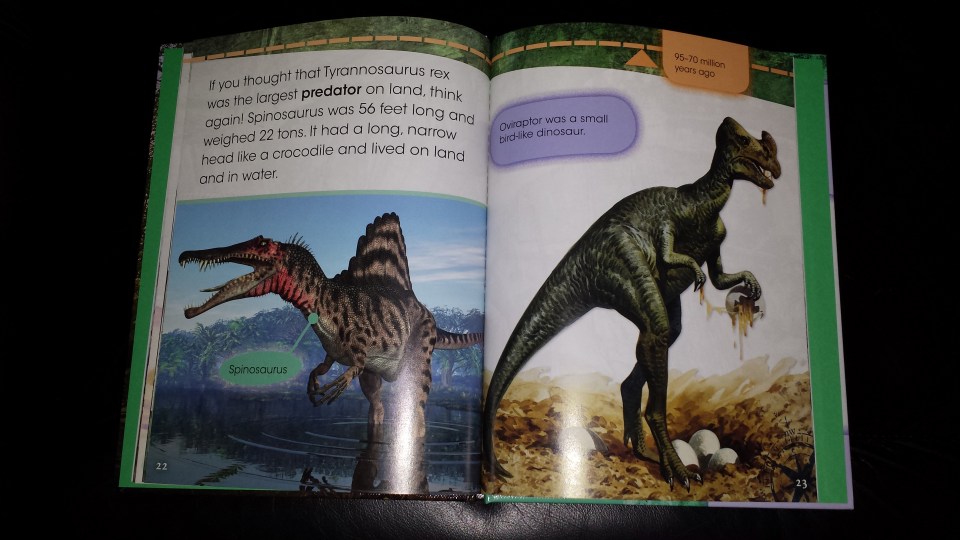
Sadly, right next to that picture is the most godawful picture of an oviraptor stealing eggs that would have been an embarrassment fifty years ago. There is a decent picture of Syntarsus, excuse me, Coelophysis, right next to a picture of Plateosaurus that was never accurate, another picture taken from a stock illustration collection with no regard for accuracy whatsoever. The Troodon just made me want to cry as it is possibly the worst I have ever seen. I am sure I have seen it before, but I don’t remember where other than it was in a book published before I was born. Pictures were taken from old books and movie stills, computer generated images, poor drawings, apparently any place they could grab them quickly. It is apparent no effort at all was made to see if the illustrations conveyed any sense of accuracy at all.
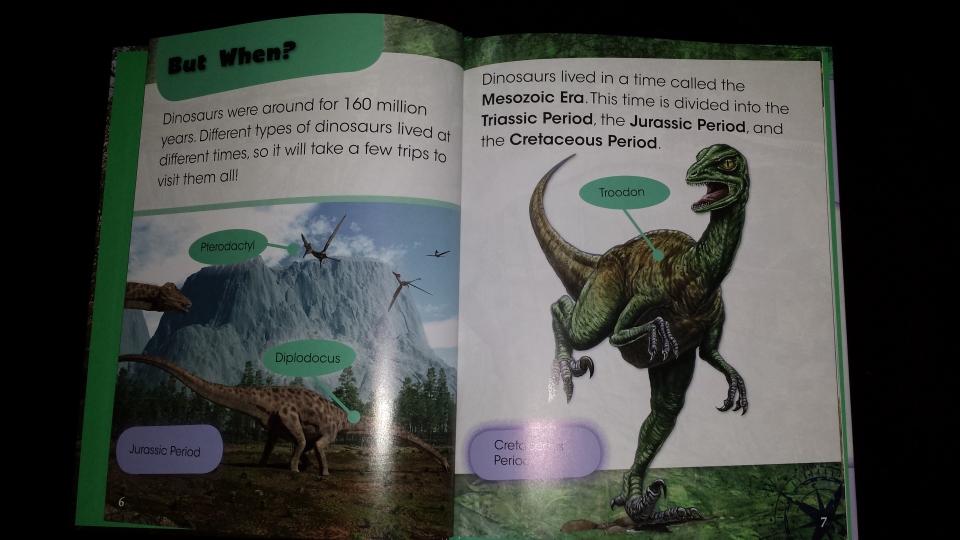
In fact, the illustrations in this book are so bad that it really doesn’t matter what the words say at all. This book was made with the apparent idea that the accuracy of the illustrations don’t matter because it is a children’s book. That is as far from the truth as it is possible to get. The artwork is the MOST important part of a children’s book. They will remember the artwork long after they have forgotten every single word in the book. The art has to be right. When the art is screwed up this badly, the words are almost pointless. Even with the mistakes in the the text, Claire Throp was done a disservice by having her work destroyed by the illustrations. It might be entertaining to a little kid, but no one who knows anything about dinosaurs will let their kids anywhere near this book except as a warning how NOT to draw dinosaurs. The only decent artwork in this book seems to be possibly pirated, so there is even that problem on top of everything else.
There is really no excuse for this. There are a lot of really excellent paleoartists who work really hard to make their work as scientifically accurate as they can while still turning out beautiful work. The art is there. The artists are there. Pay them and get quality work to make a quality product. The kids deserve that.
 The second and third books I am just going to briefly mention. One is Scholastic’s book, Dinosaurs of the Jurassic World and Beyond. Written by Paula Hammond, this book came out in 2015 to capitalize on the release of Jurassic World. Of course, what they really did was have this book on prehistoric animals that had nothing to do with Jurassic World whatsoever, notice that hey, it has a tyrannosaur in it, let’s put Jurassic World in the title and hope nobody notices that we lied our asses off about this book having anything to do with the movie so that we can sell more copies. I guess adding “and Beyond” explains not mentioning the movie and including animals like Dunkleosteus, Dimetrodon, and the Woolly Mammoth.
The second and third books I am just going to briefly mention. One is Scholastic’s book, Dinosaurs of the Jurassic World and Beyond. Written by Paula Hammond, this book came out in 2015 to capitalize on the release of Jurassic World. Of course, what they really did was have this book on prehistoric animals that had nothing to do with Jurassic World whatsoever, notice that hey, it has a tyrannosaur in it, let’s put Jurassic World in the title and hope nobody notices that we lied our asses off about this book having anything to do with the movie so that we can sell more copies. I guess adding “and Beyond” explains not mentioning the movie and including animals like Dunkleosteus, Dimetrodon, and the Woolly Mammoth.
This book also has several inaccuracies and has not exactly stellar artwork. While not as horrifyingly bad as in Weekend with Dinosaurs, it is not great. Broken wrists and unfeathered dinosaurs are common.
 The other book is Dinosaur Bites, by Heather Dakota, published by Tangerine Press. This one uses as a selling point that it comes with a necklace, of what I forget, a bronze tooth I think. Again, this suffers the same problem of poor research and bad artwork. They seem to insist on getting people who, while reasonable artists, are not familiar with their subjects and it shows in their artwork. Either that, or their book designers force them to make bad artwork to satisfy some preconceived notions, which is entirely possible.
The other book is Dinosaur Bites, by Heather Dakota, published by Tangerine Press. This one uses as a selling point that it comes with a necklace, of what I forget, a bronze tooth I think. Again, this suffers the same problem of poor research and bad artwork. They seem to insist on getting people who, while reasonable artists, are not familiar with their subjects and it shows in their artwork. Either that, or their book designers force them to make bad artwork to satisfy some preconceived notions, which is entirely possible.
Here is a gripe that I have with a lot of these books. They seem to be written by people who had their ideas about dinosaurs and other extinct animals set decades ago and they have never changed. Moreover, they don’t think it matters that they haven’t bothered to update their thinking. So they put the same thing they think they remember from their childhood. Not saying they are, but that’s what it seems like. Take for example, good old Dimetrodon. He is listed as a mammal-like reptile. Unfortunately, scientists have not used that term, really, ever. They haven’t even colloquially used that term in decades because Dimetrodon and his kin are not related to modern reptiles at all. There was a group of reptile-like animals from which two groups emerged. One group diversified into what eventually became what we think of as reptiles, along with dinosaurs and birds. The other group became mammals. Dimetrodon is in the group that became mammals. So if we are going to call them anything like that, we should be calling them something like reptile-like protomammals. Or we could just call them what scientists call them: synapsids.
Why is this important? Because it causes people to look at them differently. Dimetrodon and his kin were not reptiles with some characteristics superficially like mammals. They were animals on their way to evolving into true mammals. And that is an enormous sea change in perspective. How we talk about these creatures makes a difference.
And the winner is…
Keely Sarr, for her story, “Standardized”, but I came in second!
The Center for the Future of Museums is an initiative of the American Alliance of Museums, an organization that tries to prognosticate about what the future holds for museums and help museums plan for that future. Foretelling trends and planning for them is tough, but important if museums are going to thrive, so I try to keep up with the information they put out on whenever I can.
Earlier this year, they sponsored a contest called the Education Future Fiction Challenge for people to contribute an educational vision for museums in the year 2040. I had written fiction stories many years ago and had been thinking about wanting to do so again, but finding the time and motivation to fit it in around my nonfiction writing had not happened. So as the deadline for the contest loomed, I decided to go ahead and see what I could do. I have had this idea for a living diorama that I thought would be fun to do if we had the right technology, along with some other ideas I would love to see happen if I ever wound up with someone who had the knowledge and ability to make it happen. So I took an afternoon, wrote the first draft of the story, put it aside for a day, then came back to it for a couple of hours to edit it and sent it in, squeaking it in just under the deadline.
A couple of interesting things about this story people may be interested in. The American Museum of Natural History (AMNH) in New York does have a doctorate program in comparative biology. If it had been around in when I was looking at grad schools, I would certainly have applied. There is also really such a thing as the New York City Museum School, which is a high school run as a cooperative of several museums, including the Museum of Metropolitan Art and, at one time, although not currently, the AMNH. While AMNH doesn’t have anything like in the story yet, it does have a pretty nifty app that will really help navigating the museum and getting the most out of a visit.
The last thing about the story is that all the students in the story are named after real paleontologists. Characterizations are not reflective of the real people, although Casey is a big guy in real life, just like the Casey in this story, but otherwise, the fictional characters are not meant to represent any particular person, living or dead, other than honoring their hard work in providing the knowledge we all so enjoy reading about. The main character, RC, is named for my favorite paleontologist of all time, Roy Chapman Andrews.
You can find the story at their website, but I am posting the story here for everyone’s reading pleasure. Any scientific errors are of course mine alone, I can only plead for leniency as I was rushing to try to get it written and in quickly. I have corrected one major error already. In the original story, I referred to Majungatholus, which you will find on their website. That name is incorrect and should have been Majungasaurus, which I have corrected here. I also corrected one other minor typographical error. Now on with the story!
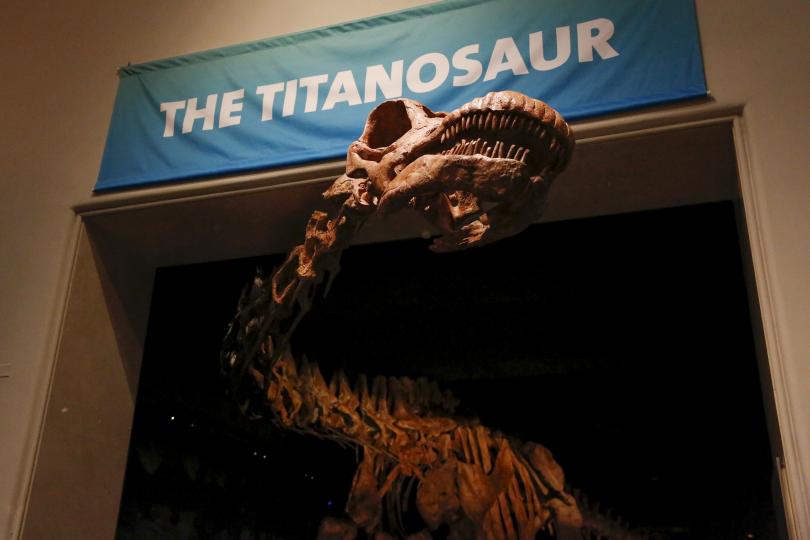
AMNH Titanosaur. Photo: Reuters. By Shannon Stapleton
Living Dinoramas at the AMNH
RC and the rest of the advanced placement class stepped into the clearing. Everything was perfect. The oppressive heat, the towering conifers shading the magnolias, which shaded the ferns and other bushes serving as undergrowth. Even the smells and sounds of the forest seemed right. There was the furry multituberculate running through the leaf litter, its rat-like whiskers twitching as it felt its way through the shadows. He could hear the rustle of the leaves as it ran across the ground. He was pretty sure it was a Gondwanathere, but he was terrible with Late Cretaceous mammals. That was Janet’s area of expertise. He saw Patrick’s Rahonavis chase after it. RC thought the iridescent bluish black feathers on the dinosaur’s back looked amazing and the famous sickle claw of the raptor looked wicked. Nancy’s plesiadapid primate ancestor scampered among the trees, its big eyes showing its nocturnal nature, which ordinarily would be counted as a mistake by the teachers in this daylight setting, but an allowed departure for this showing of their presentation. It kind of reminded him of a modern aye-aye lemur, only without the extra-long finger aye-ayes were known for.
Now was the part he was waiting for. He was so excited, he could barely contain himself as he stepped from one foot to the other and repeatedly clenched and unclenched his hands. At the edge of the clearing on either side of them, two immense dinosaurs stepped out. One the left stood Casey’s Majungasaurus in all its glory. It always made RC think if a tyrannosaur had mated with a bulldog, this would be the result: short, pug-nosed, and warty. On the right, RC’s titanosaur stepped out. Nature’s crowning glory, the largest animal to ever walk the earth, RC loved his dinosaur. As it walked out, all 40 meters of its magnificent body came into view, his head sweeping 8 meters above the ground, its tail lashing out behind it. The Majungasaurus roared. The titanosaur roared and reared up…
and collapsed on broken legs.
The scene dissolved around them, leaving the skeletons of the animals in the exhibit hall of the American Museum of Natural History’s newest exhibit on the late Cretaceous of Argentina.
Three years. THREE YEARS they had been working on this. Everything else was ready. Except his part. The disappointment and frustration was almost more than he could bear.
The AMNH had installed a series of holographic projectors and various speakers and emitters into the exhibit halls to periodically bring each of the exhibits to life. One could walk into the exhibit halls and see all the dinosaur skeletons for 45 minutes each hour, but for five minutes, they would gradually turn on the projectors, until for ten minutes it was like being in a living scene. The five minutes allowed time for people to see the skeletons fleshed out before being dropped into the full scene and before they were animated. It also allowed time for the docents to warn parents to remove small children who may become frightened by the show before it started. It also, not coincidentally, saved a fortune on electrical bills.
The museum started a doctorate program in comparative biology in 2006. As an expansion of that successful program, the museum had partnered with the New York City Museum School to sponsor an integrated program for the school’s top high school students. Each year a team of students would be allowed to choose a display hall and redesign the display, based on the newest research. The students were given the assignment at the beginning of their freshman year. During that year they would choose their teams and display hall and then they would have until the end of their senior year to present it. It required in-depth research with the exhibit curators, cross-disciplinary studies, and above all, teamwork to complete a quality project. The class of 2040 had chosen the Cretaceous Dinosaur Hall.
But time was running out. They had only one more week to present their display and everyone had finished their part except for RC.
Everyone groaned, but none louder than RC himself. Casey glared at him, which, considering that Casey was just a shade under two meters tall and used to play on the football team, could be rather intimidating. “I thought you fixed that!”
“So did I! I just can’t seem to get the physics right on that stupid thing. You try getting 80 tons to balance on two legs without breaking the bones. If I can’t get the physics equations to work right, the computer won’t allow the animation. The simulation has to be real world possible. You know that. And I can’t get this bloody thing to work.“
“Patrick and Erin got their dinosaur to fly. You can’t get yours to stand?”
“I can make a paper airplane fly too. Can you hold up a car? It’s not the biodynamics I’m having problems with. It’s the strength ratios. The legs just aren’t strong enough.”
Casey shrugged. “Well we know they existed, so we know it’s possible. What did the mechanical engineers say?”
RC snorted. “They said it was impossible. There is no way that bone of that thickness can support that much weight, even with muscle wrapped around it. It’s close, just not quite close enough.”
“Well, best figure it out soon. We’re counting on you.” Casey turned and walked off with the others.
RC threw his bag over his shoulder and started glumly strolling through the museum, hands in his pockets. After a while he found himself unsurprisingly in one of the museum’s newest exhibits, a history of robots. He particularly liked the section on robots based on different types of animals as the engineers tried to figure out how to make them walk. There were dog robots, cat robots, cheetah robots, horse robots, even salamander robots and jellyfish robots. Unfortunately, there weren’t any titanosaur robots.
There was Jennifer though. She could often be found in this section of the museum studying the robots. She said that she wanted to build robots to explore other planets. Considering that she was the smartest person on the team, RC figured she probably would. She was sitting on a bench in front of one of the exhibits sketching in her notepad. She saw him and gestured for him to come over, all the while continuing to draw.
“So how’s it going?”
“Not well.”
“Tough problem. I had a similar difficulty with the bones on the pterosaur. It just couldn’t fly using the same equations developed with birds. Birds have these massive flight muscles on their chests and strong legs. They can take a leap and use their powerful muscles to propel them into the air. Pterosaurs on the other hand, have tiny little legs. Pterosaurs couldn’t jump. They also didn’t have the keel on their sternum to hold the big flight muscles, so they couldn’t propel themselves off the ground using their wings quite as easily either.”
“So what did you do?”
“I had to look at the problem a different way. If they couldn’t fly like birds, was there some other way I could model them? Turned out they could use their wings as stilts to sort of fling themselves into the air and then start flying.”
“I don’t see how this helps with titanosaurs.”
“I don’t know…directly. But the direct approach isn’t working, is it? So see if there is another way of looking at the problem of standing. See if that gives you any ideas. Gotta run. Good luck.” She closed her notebook and hustled out.
He had no idea what to think about that as he had no idea how to think about other ways of standing. So he started walking out of the exhibit more frustrated than ever before.
And then he saw an animal robot that smacked him in the face with the answer.
The next week everything was set. Everyone walked into the exhibit hall. The class was standing around nervously, but excited. The teachers and curators were calmly curious, patiently waiting for the show to start. The parents and other onlookers were milling about looking at the displays. And RC was sweating bullets.
The lights dimmed as the holographic displays started lighting up. The sounds and smells started kicking in. Slowly movement appeared as wind started moving the foliage and small animals started moving about. The buzz of insects and chirps of birds filled the air. Then the Majungasaurus stepped in and a few parents and kids screamed. Casey laughed.
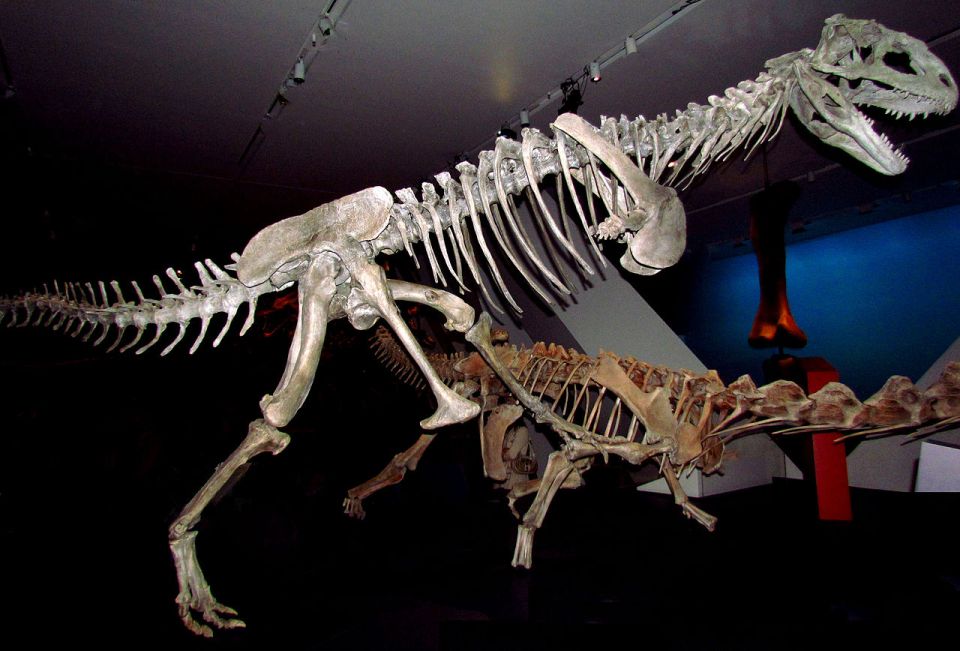
Majungasaurus, Royal Ontario Museum. By D. Gordon E. Robertson – Own work, CC BY-SA 3.0, https://commons.wikimedia.org/w/index.php?curid=22564248
Finally, RC’s titanosaur stepped out and made his way to his place. It lifted its head, roared its challenge to the Majungasaurus, and then leaned back, slapping its tail on the ground like a third leg as it reared up like the world’s biggest kangaroo before coming back down in a triumphant, titanic, stomp on Casey’s now not so majestic carnivore.

